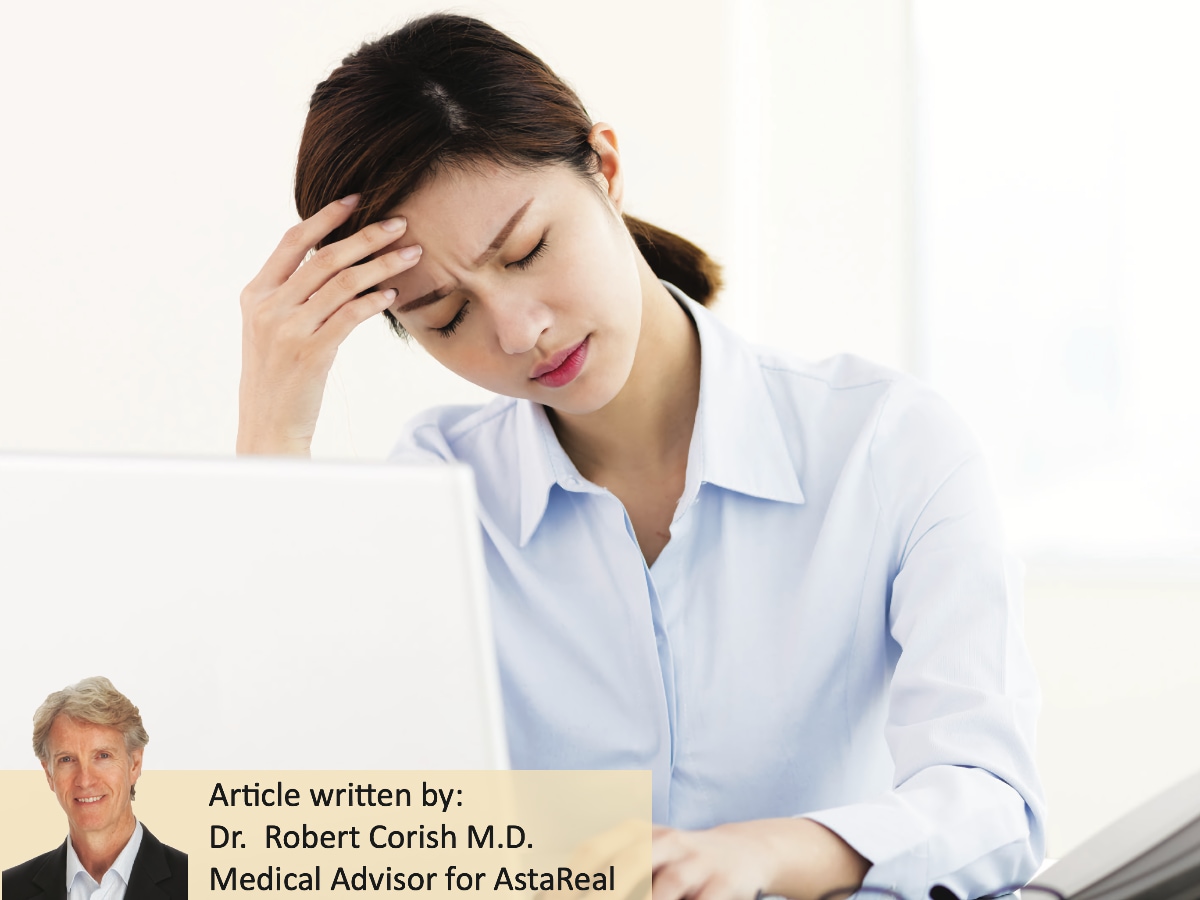Article written by:
Dr. Robert Corish M.D. Medical Advisor for AstaReal

Fatigue and Tired All the Time (TATT)
“I have no energy”, “I’m always tired” – these are the most common complaints made by people who experience fatigue. It is a universal problem that many people must deal with daily. To uproot this problem, we first must define what fatigue is and understand its causes and consequences before we can proceed to correct it.
To be clear, the kind of fatigue we are describing herein, is not the type of fatigue that is related to a disease such as heart failure, low thyroid function, anaemia, chronic fatigue. Such fatigue associated with diseases has an underlying pathological cause. Rather, the fatigue I am referring to, is the kind that everyone experiences at some point, during the day, the week and especially during stressful times, and it does not simply go away with additional rest. It makes you feel “tired all the time (TATT)”. Additionally, this common form of TATT-fatigue is a combination of both mental and physical tiredness since they are so inextricably linked together.
Classic examples of individuals who experience TATT include: busy parents – who are constantly on-the-go from morning until night, day after day, juggling between work and family…without a break! And not to forget about nurses, doctors, office workers, secretaries and executives – anyone with deadlines to meet, targets to achieve and responsibilities to fulfill. In truth, almost everyone knows how it feels to be TATT.
Biology of TATT and Mitochondria
Before we can decipher the reason behind such persistent tiredness, it is important to understand where our energy comes from to power all the activities of the body. Obviously, food is our fuel, but this fuel must first be efficiently converted into a usable form – ‘biological energy’ known as adenosine triphosphate (ATP) – which supplies the electricity that drives all the functions in the body. This ATP energy is manufactured in tiny power plants called mitochondria – found within the cells of our tissues and organs, all of which completely rely on the mitochondria to supply the energy required to function. In other words, every activity (thinking, driving, running, seeing, even breathing…) requires energy produced by the mitochondria.
As a prerequisite for this energy supply, the mitochondria within these cells rely on healthy nutrition (fuels), oxygen, water, and other targeted nutrients to function optimally. Whenever these essentials are lacking or deficient, mitochondria often struggle to produce barely sufficient energy to cope with stressful conditions. And we start to feel tired because our energy supply is unable to catch up with the requirement.
How Unhealthy Lifestyles Lead to TATT
Unhealthy and/or busy lifestyles are often the main drivers behind lower mitochondrial output and include factors such as: poor diet, insufficient sleep, inadequate hydration, lack of exercise, smoking, excess stress and over-indulgences (food and alcohol) – all of which generate excessive amounts of Reactive Oxygen Species (ROS) causing oxidative stress. ROS are harmful byproducts of metabolism and often attack healthy cells with their strong oxidizing power, causing inflammation, injury and dysfunction.
Under normal circumstances, the body handles these agitators with its own set of antioxidant defense; however, under high oxidative stress, the body’s intrinsic antioxidant reserves have been depleted, the harmful effects of excess ROS become out of control and wreak cellular havoc. This has a tremendously negative impact on the mitochondria, causing a condition known as ‘mitochondrial dysfunction’: mitochondria generate less energy, which then leads to the condition we call TATT. On a side note, it has also been suggested that mitochondrial dysfunction is one of the major hallmarks of the ageing process, which is closely associated with such persistent tiredness.
The Good News
The good news is that medical science has been able to uncover some of the main pathways involved in mitochondrial dysfunction and thus it has provided us with a ‘roadmap’ by which we can prevent further mitochondrial damage, repair damaged pathways and lead us back to a functional and optimal state. This involves adjustments and modifications in our habits towards healthy lifestyles, such as: smoking cessation, exercise, healthy diets and adequate rest can have an incredible salutary impact on overall health and wellbeing.
Moreover, it is well-documented that specific targeted nutrition can both protect and improve mitochondrial efficiency to even greater levels, but we hardly get enough antioxidant protection from an average diet, let alone the unhealthy indulgences we sometimes pamper ourselves with. Ensuring that the mitochondria in all cells, tissues and organs receive abundant nutrition and energy to perform maximally is especially important for those who experience TATT. Therefore, a mitochondria-targeted supplement is advised to insure adequate antioxidant protection that cannot be provided by diet alone.
Astaxanthin –
A Mitochondria-Targeting Nutrient Astaxanthin is a red carotenoid produced by freshwater microalgae in response to environmental stress. Astaxanthin’s unique molecular structure empowers it with potent antioxidant and anti-inflammatory properties, which allow the microalgae to withstand and repel harmful ROS, thereby preventing oxidative stress and surviving the crises.
Moreover, research has demonstrated that Astaxanthin has a high affinity for human cellular membranes and fits perfectly within the mitochondria – exactly where it is needed most to protect the mitochondria from harmful ROS.
Astaxanthin has been shown to:
1. Reduce oxidative stress associated with mitochondrial dysfunction
2. Preserve mitochondrial membrane integrity and energy production
3. Promote fatty acid (fuel) transport into the mitochondria for conversion into ready-to-use energy
4. Reduce inflammatory response in mitochondria
As mitochondria are ubiquitous in all cells of the body (except red blood cells), the protective effects of astaxanthin can be applied to multiple organ-specific TATT conditions.
Evidence-Based Anti-Fatigue Effects of Astaxanthin
Double-blind placebo-controlled studies in humans have demonstrated that astaxanthin reduces mental, visual and physical fatigue and improves endurance. One study comprised of two groups of individuals: Group A was supported by daily astaxanthin, whereas Group B received a placebo. Both groups were then subjected to a timed (30 minutes) continuous calculation challenge. The results indicated that Group A performance was superior, achieving significantly fewer errors when compared to the placebo Group B. This was particularly evident in the final 15 minutes when fatigue sets in.
The International Journal of Sports Medicine reported that professional cyclists receiving astaxanthin for 6 weeks were able to shave an average of 2 1⁄2 minutes off their 20km cycling time trials compared to placebo. In another study, a group of European soccer players who had been receiving astaxanthin exhibited reduced blood levels of inflammatory biomarkers and lower quantities of lactic acid build-up (fatigue marker) compared to placebo, indicating lower muscle fatigue.
Multiple human studies have also shown that a daily dose (6 mg) of astaxanthin reduced eye fatigue, eye strain and improved visual acuity. In a Japanese study, half of the visual display terminal (VDT) workers who suffered eye fatigue were relieved from the condition after taking daily supplement of astaxanthin for 4 weeks, whereas almost everyone from the placebo group continued to experience eye fatigue.
All of these studies reflect astaxanthin’s fatigue- fighting effects as they pertain to mitochondrial function, which is crucial in ensuring efficient energy production for the activities involved. Such targeted nutrition, together with healthy lifestyles, good hydration and stress relief will not only resist the fatigue of the daily grind, it will also pay huge dividends in improving energy levels, performance measures and overall wellness.
However, the only dietary sources of natural astaxanthin for humans are red seafood such as wild caught Alaskan Sockeye salmon, and it requires kilograms of salmon to be eaten every day to capture natural astaxanthin’s health benefits. It is therefore recommended to obtain high quality natural astaxanthin in the form of health supplements, in order to reach the therapeutic levels of natural astaxanthin shown in clinical studies.
